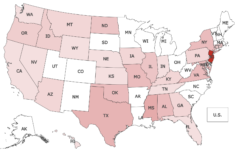 Legislation requiring state agencies to publish official notice on their websites was killed last week in committees in Indiana, Georgia and West Virginia.
Legislation requiring state agencies to publish official notice on their websites was killed last week in committees in Indiana, Georgia and West Virginia.
After passing the House last month by a comfortable margin, Indiana HB-1312 was defeated in a Senate committee by a vote of 8-2. The bill allowed every public notice in the state to eventually be posted on a state-agency website. It was rejected a week after the Hoosier State Press Association (HSPA) organized a statehouse rally at which “more than 100 Indiana publishers, editors, reporters and subscribers gathered outside the Senate chambers” to oppose the bill, according to Johnston County’s Daily Journal.
Three states edge closer to government website notice
 Legislation that would move all or most public notice in three states to government websites passed significant milestones last month. Bills in Indiana and Kentucky were approved by the Houses of Representatives in those states by comfortable margins, while another in Idaho’s lower chamber barely squeaked by.
Legislation that would move all or most public notice in three states to government websites passed significant milestones last month. Bills in Indiana and Kentucky were approved by the Houses of Representatives in those states by comfortable margins, while another in Idaho’s lower chamber barely squeaked by.
The most significant threat to newspaper notice appears to be the assault launched in Indiana, where HB-1312 would eventually allow all public and private notices in the state to be posted on a website established by the Indiana Office of Technology (IOT). It passed the House on Feb. 18 by a 57-36 vote.
Legislative floodgates open
 Every January, we are inundated with a firehose of public notice bills gushing from legislatures ranging from Connecticut to California and most states in-between. This year has been no different. PNRC is now following 83 separate pieces of legislation which almost certainly doesn’t include many other most-likely minor bills we haven’t been able to catch up with yet.
Every January, we are inundated with a firehose of public notice bills gushing from legislatures ranging from Connecticut to California and most states in-between. This year has been no different. PNRC is now following 83 separate pieces of legislation which almost certainly doesn’t include many other most-likely minor bills we haven’t been able to catch up with yet.
Indiana adopts digital-newspaper notice
 Indiana Gov. Eric Holcomb signed three bills last month that will impact the state’s public notice laws. When it takes effect on July 1, the most significant bill will make Indiana the first state to authorize government units to publish primary notice on some newspaper websites or e-editions.
Indiana Gov. Eric Holcomb signed three bills last month that will impact the state’s public notice laws. When it takes effect on July 1, the most significant bill will make Indiana the first state to authorize government units to publish primary notice on some newspaper websites or e-editions.
House Bill 1204, which passed both the House and Senate unanimously, allows local governments and state agencies to circumvent the print editions of most newspapers by posting notices in one of their digital products as an alternative. However, the bill only applies to newspapers that distribute fewer than four editions per week; print will remain the exclusive means for government notice in papers that are published more frequently.
February brings more evidence of shift to newspaper websites
 Last month provided additional confirmation that state legislatures are increasingly looking to newspaper websites rather than government sites to supplement and perhaps eventually serve as an alternative to printed newspapers as the primary medium for public notice. Bills illustrating that trend moved closer to becoming law in both Indiana and Iowa.
Last month provided additional confirmation that state legislatures are increasingly looking to newspaper websites rather than government sites to supplement and perhaps eventually serve as an alternative to printed newspapers as the primary medium for public notice. Bills illustrating that trend moved closer to becoming law in both Indiana and Iowa.
Indiana
The tenor of public notice legislation has shifted in Indiana. At the start of 2023 it was one of the two or three states that seemed most likely to abandon newspapers in favor of government websites. Yesterday the legislature approved a bill that could instead serve as a gateway to an eventual migration to newspaper websites.
Public notice in Florida in peril once again
 Our original headline for this story was “Newspaper notice off to good start in 2022.” But late last night we learned that Florida — a state that last year passed a progressive bill paving the way for the eventual migration of statutory notice to newspaper websites — was in play once again.
Our original headline for this story was “Newspaper notice off to good start in 2022.” But late last night we learned that Florida — a state that last year passed a progressive bill paving the way for the eventual migration of statutory notice to newspaper websites — was in play once again.
We haven’t had time to digest the 40-page bill, but it’s clearly designed to undo the work that went into last year’s historic legislation by moving public notice to government websites. The committee bill passed out of the Judiciary Committee this morning with GOP backing on a straight party-line vote.
Indiana courts consider website-only notice
 The Hoosier State Press Association (HSPA) thought it had a year to design the future of public notice. That turned out not to be the case.
The Hoosier State Press Association (HSPA) thought it had a year to design the future of public notice. That turned out not to be the case.
The latest encroachment on HSPA’s turf came from the Indiana Supreme Court, which recently proposed amending the state’s rules of trial procedure to allow court notices to be posted on something called the Indiana Court Legal Notice Website in lieu of newspaper publication. According to HSPA Executive Director Steve Key, the rule would encompass notices mandated in connection with foreclosure sales, estate administration, lawsuit summons and name changes. Key said his understanding is the website notices would be free of charge to the individuals required to publish them.
In Indiana, future of notice arrives earlier than expected
 By the time Indiana’s 2020 legislative session had ended, the Hoosier State Press Association promised leadership in both chambers it would begin working on a proposal outlining what notice in the state might look like in a future in which print newspapers were no longer its primary vehicle. Like other state press groups, HSPA would prefer to keep public notice in newspapers, where they belong. But the newspaper group was bowing to reality, according to Executive Director Steve Key. After mostly holding off 91 bad public notice bills in the past 21 legislative sessions, even erstwhile supporters in the legislature were telling Key it was time to look to the future.
By the time Indiana’s 2020 legislative session had ended, the Hoosier State Press Association promised leadership in both chambers it would begin working on a proposal outlining what notice in the state might look like in a future in which print newspapers were no longer its primary vehicle. Like other state press groups, HSPA would prefer to keep public notice in newspapers, where they belong. But the newspaper group was bowing to reality, according to Executive Director Steve Key. After mostly holding off 91 bad public notice bills in the past 21 legislative sessions, even erstwhile supporters in the legislature were telling Key it was time to look to the future.
New Kentucky public notice law maintains status quo ante
 After following a convoluted path that included two different bills, half a dozen amendments, five floor votes and a grand compromise, the Kentucky legislature passed a bill last week ensuring that the state’s public notice law would remain mostly unchanged.
After following a convoluted path that included two different bills, half a dozen amendments, five floor votes and a grand compromise, the Kentucky legislature passed a bill last week ensuring that the state’s public notice law would remain mostly unchanged.
The original public notice provisions of both HB195 and HB351 would have moved all government notice in the Bluegrass State from newspapers to government websites. Following a compromise earlier this year between the Kentucky Press Association (KPA) and the associations representing cities and counties in the state, HB195 was amended to exclude counties with population under 80,000. That amendment brought it closer to the state’s current law — passed two years ago and due to sunset this summer — which allows counties with population above 90,000 to run notices on their own websites; decreasing the population threshold by 10,000 would have increased the number of website-notice-only counties from eight to ten.
Hoosier State Press Association inaugural public notice summit rallies publishers
 A close call during this year’s legislative session put the fear of god into newspaper industry leaders in Indiana. The Hoosier State Press Association responded by convening a Public Notice Summit, which was held Sept. 13 during the association’s annual conference and advertising awards gala.
A close call during this year’s legislative session put the fear of god into newspaper industry leaders in Indiana. The Hoosier State Press Association responded by convening a Public Notice Summit, which was held Sept. 13 during the association’s annual conference and advertising awards gala.
“We had a big scare in our last session,” said HSPA Executive Director Steve Key, referring to a bill that was introduced in the state House that would have eliminated foreclosure notices in Indiana newspapers. “The bill got a hearing but died in a Senate committee.”
